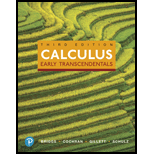
Concept explainers
Analyzing models The following models were discussed in Section 9.1 and reappear in later sections of this chapter. In each case, carry out the indicated analysis using direction fields.
Chemical rate equations Consider the chemical rate equations y′(t) = −ky(t) and y′(t) = − ky2(t), where y(t) is the concentration of the compound for t ≥ 0, and k > 0 is a constant that determines the speed of the reaction. Assume the initial concentration of the compound is y(0) = y0 > 0.
- a. Let k = 0.3 and make a sketch of the direction fields for both equations. What is the equilibrium solution in both cases?
- b. According to the direction fields, which reaction approaches its equilibrium solution faster?
Want to see the full answer?
Check out a sample textbook solution
Chapter 9 Solutions
Calculus: Early Transcendentals (3rd Edition)
Additional Math Textbook Solutions
Basic Business Statistics, Student Value Edition
Pre-Algebra Student Edition
Calculus: Early Transcendentals (2nd Edition)
Elementary Statistics (13th Edition)
Thinking Mathematically (6th Edition)
A First Course in Probability (10th Edition)
- can you solve this question using partial fraction decomposition and explain the steps used along the wayarrow_forwardIntegral How 80*1037 IW 1012 S е ऍ dw answer=0 How 70+10 A 80*1037 Ln (Iwl+1) du answer=123.6K 70*1637arrow_forwardcan you solve this question and explain the steps used along the wayarrow_forward
- can you solve this question and explain the steps used along the wayarrow_forwardcan you solve this question and explain the steps used along the wayarrow_forwardCan the expert solve an Intestal In detall? 110x/0³ W. 1 SW = dw A 40x103π ⑤M-1 大 80*10³/ 12 10% 70*1037 80x103 || dw OP= # Sin (w/+1) dw A 70*10*Aarrow_forward
- After a great deal of experimentation, two college senior physics majors determined that when a bottle of French champagne is shaken several times, held upright, and uncorked, its cork travels according to the function below, where s is its height (in feet) above the ground t seconds after being released. s(t)=-16t² + 30t+3 a. How high will it go? b. How long is it in the air?arrow_forward+6x²+135x+1) (0≤x≤10). a) Find the number of units The total profit P(x) (in thousands of dollars) from a sale of x thousand units of a new product is given by P(x) = In (-x²+6x² + 135x+ that should be sold in order to maximize the total profit. b) What is the maximum profit?arrow_forwardThe fox population in a certain region has an annual growth rate of 8 percent per year. It is estimated that the population in the year 2000 was 22600. (a) Find a function that models the population t years after 2000 (t = 0 for 2000). Your answer is P(t) = (b) Use the function from part (a) to estimate the fox population in the year 2008. Your answer is (the answer should be an integer)arrow_forward
- Algebra & Trigonometry with Analytic GeometryAlgebraISBN:9781133382119Author:SwokowskiPublisher:Cengage
 College Algebra (MindTap Course List)AlgebraISBN:9781305652231Author:R. David Gustafson, Jeff HughesPublisher:Cengage Learning
College Algebra (MindTap Course List)AlgebraISBN:9781305652231Author:R. David Gustafson, Jeff HughesPublisher:Cengage Learning

